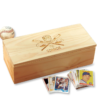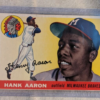Baseball Card Size: A Glimpse into Collectible History
Baseball cards are not just pieces of cardboard; they are windows into the rich tapestry of America’s favorite pastime. One of the defining characteristics of these collectibles is their size. In this article, we’ll explore the intriguing world of baseball card size, its evolution, and how it has played a significant role in the hobby of card collecting.
A Compact Slice of Baseball History
Baseball cards have been captivating fans and collectors for over a century. One of the distinctive features of these cards is their size, which has evolved over time. Here are some key milestones in the history of baseball card dimensions:

Pre-1900s: Cabinet Cards
Before the widespread popularity of standard-sized baseball cards, cabinet cards were produced. These were large-format photographs mounted on cardboard, often measuring around 4.25 by 6.5 inches. They featured individual players or teams and were prized possessions of the era.
1900s: Tobacco Cards and the Birth of the Standard Size
In the early 1900s, tobacco companies started including baseball cards in cigarette packs. These cards were smaller and more convenient to collect than cabinet cards, measuring approximately 1.5 by 2.625 inches. The iconic T206 set, featuring players like Honus Wagner, is a notable example from this era.
1950s: The Standard Size Becomes Common
The 1950s marked the era when the modern standard size for baseball cards was established. Cards from this period, like the 1952 Topps Mickey Mantle, measured about 2.5 by 3.5 inches. This size became the industry norm and remains the standard for most baseball cards today.
Why Standard Size Matters
The adoption of a standard size for baseball cards was not a mere coincidence; it had several practical advantages that contributed to the hobby’s growth:
- Uniformity: Standard-sized cards were easy to handle, store, and display, making them accessible to collectors of all ages.
- Trading and Collecting: The consistent size allowed collectors to organize, trade, and store cards efficiently. It became the basis for pricing guides, checklists, and grading standards.
- Packaging and Distribution: Card manufacturers could package cards in uniform stacks, facilitating production and distribution.
- Design Consistency: The standardized size provided a canvas for designers to create visually appealing card layouts, which became a hallmark of the hobby.

Specialty Sizes and Variations
While the standard size is prevalent, the hobby also features specialty sizes and variations that add diversity to collections. These include oversized cards, mini-cards, and jumbo cards. These unique sizes often accompany special sets, anniversary editions, or promotional releases, offering collectors a chance to diversify their collections.
Size as a Time Capsule
In conclusion, the baseball card size is more than just a dimension; it’s a window into the history and evolution of the card collecting hobby. From the larger cabinet cards of the 19th century to the standardized 2.5 by 3.5-inch cards of today, size has played a crucial role in making these collectibles accessible, collectible, and cherished by fans and collectors alike. It’s a testament to the enduring fascination with America’s pastime and the unique way it intertwines with our culture and history.


